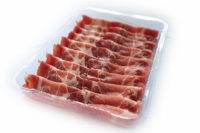For the most part, “biopolymer packaging materials” and terms such as “functional performance” and “good value” don’t occur in the same conversations within the meat industry. The varied shortcomings of renewably sourced packaging alternatives, generally, have outpaced their benefits. Right ideas, but not yet developed enough.
However, what if a marriage of performance and sustainability were possible today? Would anyone embrace change? For modified-atmosphere packaging (MAP), if a few manufacturers’ claims are accurate, change may be within grasp. Let’s be clear, this would not be driven by shortcomings of traditional MAP materials because, frankly, they all perform well. It would be more market-based change.
Many marketers are interested in a sustainable label on their packages in order to satisfy their own corporate mission and to take advantage of shoppers’ affection for products that bolster their feelings of environmental responsibility. What has not been available is a barrier package alternative with a renewable and sustainable footprint, according to one manufacturer. And here is where the picture gets interesting.
There appear to be some truly innovative options whose gas barrier claims are so bold to place, almost as an afterthought, the fact that they are also made from up to 80 percent renewable content. The reported oxygen transmission rates are less than one-tenth of one percent. Consequently, the additional shelf-life they provide for fresh meats is said to be in the range of 15 percent to 40 percent, depending on the application and conditions.
Another adds recyclability to its high-barrier properties. Its PET skins combine with up to 60 percent renewable content, enabling the material to be fully recycled with the PET recovered in the traditional recycling streams.
Others claim 100 percent renewable using “green” polyethylene made from sugar cane. The polyethylene is identical to its petroleum-based brother, but comes from different starter materials.
All of this performance, renewability and recyclability surely must come with a hefty price. The manufacturers beg to differ and say that prices have come down. They claim they can be at cost parity with traditional MAP materials.
How? Typically, by down-gauging.
Their logic follows that generally, a barrier material like EVOH will comprise somewhere around five percent of a film’s structure, whereas these renewable structures may have two-thirds or more barrier content. So, for example, a renewable 450-micron tray could replace a traditional 650-micron tray, still deliver better barrier properties and do it at a competitive price, according to this same source. Most of these materials are available in pre-made rigid trays; and rigid and flexible thermoform roll stock.
Everyone’s opinion about the viability and veracity of these materials is different. That’s healthy skepticism, and history shows it is warranted. But, perhaps everyone can agree that, at least, they deserve our curious attention as they develop because the possibilities can’t be ignored.





Report Abusive Comment